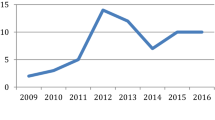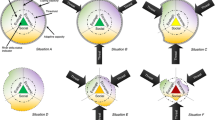Abstract
The aim of this paper is to introduce scale as a basic tool for improving the conceptual structure of vulnerability assessments. The terminology useful for vulnerability assessments and the current use of scale issues in theoretical vulnerability frameworks will be discussed briefly. Two case studies working on sub-national and on local level will demonstrate problems as well as benefits resulting from scale implications. Both assessments analyse vulnerability in context to river floods in Germany. In order to develop a spatial comparison and to integrate topics like environment and society, vulnerability assessments need to be aware of scale implications. The main point is that a scale debate on a broader spectrum than just in technical spatial terms is missing in vulnerability and risk conceptualisations so far. Vulnerability assessments and scale are highly intertwined, not only in technical application but also in conceptualisation, which needs more scientific development.




Similar content being viewed by others
References
Abella EAC, Van Westen CJ (2007) Generation of a landslide risk index map for Cuba using spatial multi-criteria evaluation. Landslides 4:311–325
Adger WN (2006) Vulnerability. Glob Environ Change 16:268–281
Albrecht J, Car A (1999) GIS analysis for scale-sensitive environmental modelling based on hierarchy theory. In: Dikau R, Saurer H (eds) GIS for earth surface systems. Analysis and modelling of the natural environment. Borntraeger, Stuttgart
Allen TFH, Starr TB (1982) Hierarchy: perspectives for ecological complexity. University of Chicago Press, Chicago
Anderson MB, Woodrow PJ (1998) Rising from the ashes: development strategies in times of disaster. Lynne Rienner, Boulder
BBR (2007) INKAR 2006. Indikatoren, Karten und Graphiken zur Raum- und Stadtentwicklung in Deutschland und in Europa, BBR - Bundesamt für Bauwesen und Raumordnung (Federal Office for Building and Regional Planning), Bonn
Berkes F (2006) From community-based resource management to complex systems. Ecol Soc 11:1
Bian L (1997) Multiscale nature of spatial data in scaling up environmental models. In: Quattrochi DA, Goodchild MF (eds) Scale in remote sensing and GIS. CRC, Boca Raton
Birkmann J (ed) (2006) Measuring vulnerability to natural hazards: towards disaster resilient societies. United Nations University Press, Tokyo
Birkmann J (2007) Risk and vulnerability indicators at different scales: applicability, usefulness and policy implications. Environ Hazards 7:20–31
BKG (2007) Basis-DLM and VG250. Federal Agency for Cartography and Geodesy (BKG), Germany
Bohle H-G (2007) Living with vulnerability. Livelihoods and human security in risky environments, intersections no. 6/2007, United Nations University—Institute for Environment and Human Security [UNU-EHS], Bonn
Brooks N (2003) Vulnerability, risk and adaptation: a conceptual framework, working paper 38. Tyndall Centre for Climate Change Research, Norwich
Cao C, Lam NS-N (1997) Understanding the scale and resolution effects in remote sensing and GIS. In: Quattrochi DA, Goodchild MF (eds) Scale in remote sensing and GIS. Lewis, Boca Raton
Cash DW, Moser SC (2000) Linking global and local scales: designing dynamic assessment and management processes. Glob Environ Change 10:109–120
Cash DW, Adger WN, Berkes F et al (2006) Scale and cross-scale dynamics: governance and information in a multilevel world. Ecol Soc 11:2
Cutter SL (1996) Vulnerability to environmental hazards. Prog Hum Geogr 20(4):529–539
Damm M (2008) A socio-ecological vulnerability assessment for Germany. In: Simonovic SP, Bourget PG, Blanchard SF (eds) Managing flood risk, reliability & vulnerability. Proceedings of the 4th international symposium on flood defence, 6–8 May 2008. Institute for Catastrophic Loss Reduction, Toronto
Damm M, Fekete A, Uhlemann S et al (2006) Development of an information system for large-scale flood events supported by remote sensing (project DISFLOOD), Beiträge zur Konferenz “Strategien und Instrumente zur Verbesserung des vorbeugenden Hochwasserschutzes” 23–25 November 2005 in Tangermünde, In: Jüpner R (ed) Band 6 (2006) Magdeburger Wasserwirtschaftliche Hefte, Shaker, pp 133–141
Destatis (2006) Statistik regional 2006. Federal Statistical Office, Germany
DFID (2001) Sustainable livelihoods guidance sheets. London, Department for International Development (UK). http://www.dfid.gov.uk/. Retrieved 25 Jan 2006
DLR-DFD (2007) CORINE Land Cover 2000. German Aerospace Centre—German Remote Sensing Data Center Oberpfaffenhofen (DLR-DFD)
Fekete A (2009) Validation of a social vulnerability index in context to river-floods in Germany. Nat Hazards Earth Syst Sci 9:393–403
Fekete A, Birkmann J (2008) Assessing social vulnerability to floods on sub-national scale. In: Simonovic SP, Bourget PG, Blanchard SF (eds) Managing flood risk, reliability & vulnerability. Proceedings of the 4th international symposium on flood defence, 6–8 May 2008. Institute for Catastrophic Loss Reduction, Toronto
Few R (2003) Flooding, vulnerability and coping strategies: local responses to a global threat. Prog Dev Stud 3(1):43–58
Gallopín GC (2006) Linkages between vulnerability, resilience, and adaptive capacity. Glob Environ Change 16:293–303
Gibson C, Clark C, Ostrom E, Ahn T-K (2000) The concept of scale and the human dimensions of global change: a survey. Ecol Econ 32:217–239
Gunderson LH, Holling CS (2002) Panarchy. Understanding transformations in human and natural systems. Island, Washington
Hewitt K (1983) Interpretations of calamity: from the viewpoint of human ecology (the risks & hazards series, 1). Allen & Unwin, Winchester
Holling CS (1973) Resilience and stability of ecological systems. Annu Rev Ecol Syst 4:1–23
Holling CS, Gunderson LH, Ludwig D (2002) In quest of a theory of adaptive change. In: Gunderson LH, Holling CS (eds) Panarchy. Understanding transformations in human and natural systems. Island, Washington
IKSR (2001) Rheinatlas, IKSR—Internationale Kommision zum Schutz des Rheins (International Commission for the Protection of the Rhine), Koblenz, Germany
Jeffers JNR (1988) Statistical and mathematical approaches to issues of scales in ecology. In: Rosswall T, Woodmansee RG, Risser PG (eds) Scope 35: scales and global change: spatial and temporal variability in biospheric and geospheric process. Wiley, Chichester
Jenerette GD, Wu J (2000) On the definitions of scale. Bull Ecol Soc Am 81(1):104–105
Kasperson JX, Kasperson R, Dow K (2001) Global environmental risk and society. In: Kasperson JX, Kasperson R (eds) Global environmental risk. United Nations University Press, Earthscan, London
Kienberger S (2007) Assessing the vulnerability to natural hazards on the provincial/community level in Mozambique: the contribution of GIscience and remote sensing, Joint CIG/ISPRS conference on geomatics for disaster and risk management, Toronto, Canada
Koestler A (1967) The ghost in the machine, German edition 1968. Fritz Molden, Wien
Leitner H, Miller B (2007) Scale and the limitations of ontological debate: a commentary on Marston, Jones and Woodward. Trans Inst Br Geogr 32:116–125
Levin SA (1992) The problem of pattern and scale in ecology: the Robert H. MacArthur Award Lecture. Ecology 73(6):1943–1967
Luhmann N (1984) Soziale Systeme. Grundriß einer allgemeinen Theorie. Suhrkamp, Frankfurt/Main
Marston SA (2000) The social construction of scale. Prog Hum Geogr 24(2):219–242
MEA (2003) Ecosystems and Human Well-being. A framework for Assessment. Island Press, World Resources Institute, Washington
Meentemeyer V (1989) Geographical perspectives of space, time, and scale. Landscape Ecol 3(3/4):163–173
O’Brien K, Leichenko R, Kelkar U et al (2004) Mapping vulnerability to multiple stressors: climate change and globalization in India. Glob Environ Change 14:303–313
O’Neill RV (1988) Hierarchy theory and global change. In: Rosswall T, Woodmansee R, Risser PG (eds) SCOPE 35—scales and global change—spatial and temporal variability in biospheric and geospheric processes. Wiley, Chichester
Openshaw S (1984) The modifiable areal unit problem. Geo, Norwich
Openshaw S (ed) (1995) Census user’s handbook. GeoInformation International, Cambridge
Peterson GD (2000) Scaling ecological dynamics: self-organization, hierarchical structure and ecological resilience. Clim Change 44(3):291–309
Peterson DL, Parker VT (eds) (1998) Ecological scale. Theory and applications. Colombia University Press, New York
Quattrochi DA, Goodchild MF (eds) (1997) Scale in remote sensing and GIS. Lewis, Boca Raton
Robinson WS (1950) Ecological correlations and the behavior of individuals. Am Sociol Rev 15(3):351–357
Sarkar S (1984) Book review: hierarchy: perspectives for ecological complexity by Allen, T.F.H and Starr, Thomas B. Philos Sci 51(2):359–361
Stephen L, Downing TE (2001) Getting the scale right: a comparison of analytical methods for vulnerability assessment and household-level targeting. Disasters 25(2):113–135
Thywissen K (2006) Components of risk. A Comparative Glossary, SOURCE 2/2006, UNU-EHS. 52
Turner MG, Dale VH, Gardner RH (1989) Predicting across scales: theory development and testing. Landscape Ecol 3(3/4):245–252
Turner BL, Kasperson RE, Matson PA et al (2003) A framework for vulnerability analysis in sustainability science. Proc Natl Acad Sci USA 100(14):1–6
Villagrán de León JC (2006) Vulnerability. A Conceptual and Methodological Review, SOURCE 4/2006, UNU-EHS, p 68
Von Bertalanffy KL (2006) General system theory: foundations, development, applications, revised edition. George Braziller, New York
Waldrop MM (1992) Complexity. The emerging science at the edge of order and chaos. Edition of 1994. Penguin, London
Watson MK (1978) The scale problem in human geography. Geogr Ann Ser B 60(1):36–47
White GF, Kates RW, Burton I (2001) Knowing better and losing even more: the use of knowledge in hazards management. Environ Hazards 3:81–92
Wiens JA (1989) Spatial scaling in ecology. Funct Ecol 3:385–397
Wilbanks TJ, Kates RW (1999) Global change in local places: how scale matters. Clim Change 43(3):601–628
Wisner B, Blaikie P, Cannon T et al (2004) At risk—natural hazards, people’s vulnerability and disasters, 2nd edn. Routledge, London
Wu J, Li H (2006) Concepts of scale and scaling. In: Wu J, Jones KB, Li H, Loucks OL (eds) Scaling and uncertainty analysis in ecology. Springer, Dordrecht
Acknowledgments
This paper is based on a presentation on the German Congress of Geographers, from September 29th to October 5th 2007, in Bayreuth, Germany, in the special session of the working group on natural hazards/natural risks entitled “extreme events in environment and society – the question of scale”, with this biennium’s central theme “Handling Risks: Disasters – Destabilisation – Security”. It has further been presented on the EGU General Assembly 2008 in Vienna, Austria in session NH9.3 Vulnerability analysis in natural hazards and risk assessments (Abstract accessible at: http://www.cosis.net/abstracts/EGU2008/03903/EGU2008-A-03903.pdf). We are grateful to the organisers, especially Thomas Glade, and for the feedback received on both events. We would also like to express our gratitude to the two anonymous reviewers for their instructive and thoughtful suggestions and feedback.
Author information
Authors and Affiliations
Corresponding author
Rights and permissions
About this article
Cite this article
Fekete, A., Damm, M. & Birkmann, J. Scales as a challenge for vulnerability assessment. Nat Hazards 55, 729–747 (2010). https://doi.org/10.1007/s11069-009-9445-5
Received:
Accepted:
Published:
Issue Date:
DOI: https://doi.org/10.1007/s11069-009-9445-5




